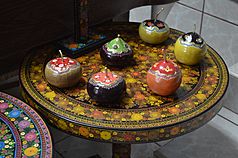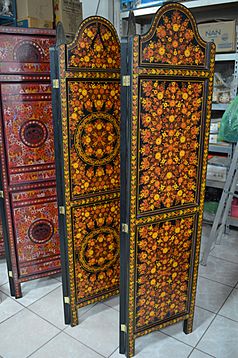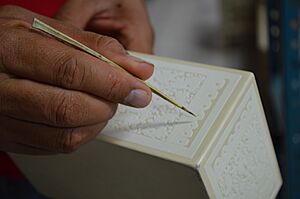Olinalá (craftwork) facts for kids
The olinalá is a special way of decorating objects with a shiny finish, like a type of paint or varnish. It comes from a town called Olinalá in Guerrero, Mexico. People who make olinalá often use a special wood from the linaloe tree (Bursera linanoe). This wood is loved for its amazing smell and grows naturally in the area. The art of olinalá is very important to the local communities, especially those who speak Nahuatl and Tlapanec.
While olinalá is most famous for decorating boxes and trunks, artists also use this technique on many other things. These include trays, fruit bowls, small boxes for jewelry, folding screens, headboards for beds, seats, frames for mirrors and paintings, and even breadboxes or special bowls called tecomates (made from calabash).
Since 1994, olinalá has been recognized as one of the 16 Mexican Designations of Origin. This means it's a unique product from Mexico, protected like a special brand.
Contents
How Olinalá is Made
Making olinalá objects involves several careful steps, from preparing the wood to adding the beautiful designs.
Preparing the Wood
Getting Linaloe Wood
The linaloe tree, also called olinaloe, is very special. Its name means "oily wood" in Latin, and in Nahuatl, it's called xochicopal, meaning "fine copal" (a type of resin). This tree grows in dry forests in parts of Mexico like Guerrero and Oaxaca. Its fruit is used to make a fragrant linaloe oil.
Linaloe wood is highly valued for olinalá because of its unique smell. Other woods like red cedar are also used. To make the wood even more fragrant, artists use a process called cala. This means making cuts in the living tree's trunk, usually in August or September during the rainy season. The tree sends its sap to the cuts, and this sap mixes with water. This creates dark, "veined" patterns in the wood, which are actually the fragrant essential oil that gives the wood its wonderful scent.
Some makers skip the cala process. This makes the furniture cheaper, but it won't smell as strong.
Working with the Wood
After the wood is gathered, it's prepared for decoration. First, the wooden boards are brushed to make them smooth. Then, the pieces are put together to form the box or furniture. An insecticide is applied to protect the wood from bugs. After a few days, any holes are filled (resanar) and the surface is sanded (lijar) until it's very smooth. Because the linaloe trees are not huge, the furniture made from them is usually not very large either.
The Lacquer Process
The lacado (lacquering or varnishing) process is key to olinalá's beauty. The most important ingredient is a special stone called tóctetl (which is dolomite). This stone is found in the region. It's heated, then ground into a fine powder using a metate (a traditional grinding stone). This powder is mixed with oak charcoal to create a black color.
Natural pigments are also used, coming from things like flower petals or even mealybugs. A second layer uses tecoxtle, which is an iron oxide. This is mixed with chia oil (called chamate) to help the layers stick together. The third layer is texicaltetl (or tezicaltetl), which is calcium carbonate. This is mixed with the desired colored earth, and the result is called tlapezole. Chia oil and texicaltetl help make the varnish shiny.
All the layers must be applied evenly, sometimes using quartz polishers. Once the lacquer is finished, it rests for 10 to 15 days before the next step.
Adding Ornaments
Sgraffito Designs
After the lacquer dries, artists begin the rayado (scratching) process, also known as sgraffito. This involves drawing by scratching into the lacquer. They use a guajolote (turkey) feather with a sharp maguey or huizache thorn at the tip. Each artist has their own style, but common designs include plants and animals.
Adding Precious Metals
Sometimes, olinalá crafts also feature inlaid precious metals like gold or silver. A thin layer of the metal is carefully added over the lacquer and scratched design. This requires special tools, like a cushion for working gold and tweezers.
Painting and Gold Details
The final step is pintado (painting). Artists use very fine brushes made from turkey feathers with a cat's hair inserted at the tip. This allows them to paint very detailed designs that cover the entire surface of the object. They use natural powder pigments mixed with sisa (an oil-based glue for gold), which is a type of oil paint.
Again, each painter has a unique style, but flowers are a very popular design. Abstract, geometric, and animal shapes are also common. The drawings often have a simple, naïve style and are very colorful, creating a beautiful contrast with the glossy black background of the lacquered piece.
Caring for Olinalá Wood
Linaloe wood is naturally appealing to many kinds of larvae and moths, so an insecticide must be applied during its creation. Over time, the wood's special scent might fade. To help the perfume last longer, it's best to keep olinalá boxes closed and away from direct sunlight. You can also apply a little linaloe oil (extracted from the tree's fruit) to the wood from time to time.
Protecting and Promoting the Craft
To help keep this amazing craft alive and popular, the Olinalá Work Training Unit (UCAT Olinalá) was started in 2013. This center teaches carpentry, traditional varnishing, and the rayado (scratching) and dorado (gold work) techniques. Another related center in Taxco specializes in working with precious metals, as Taxco is famous for its metal traditions. The hinges used in Olinalá boxes often come from Taxco.
On September 5, 1994, the Mexican government officially protected Olinalá handicrafts as a Denomination of Origin (DO). This means the government is committed to saving, preserving, and promoting this ancient art form. This protection also led to the creation of a Regulatory Council (CR Olinalá) and rules to ensure the quality of the pieces. This helps prevent fake products and stops people from using cheaper materials or skipping important steps in the traditional process. The quality standards were developed by the CR and the UNAM.
See also
 In Spanish: Olinalá (artesanía) para niños
In Spanish: Olinalá (artesanía) para niños






